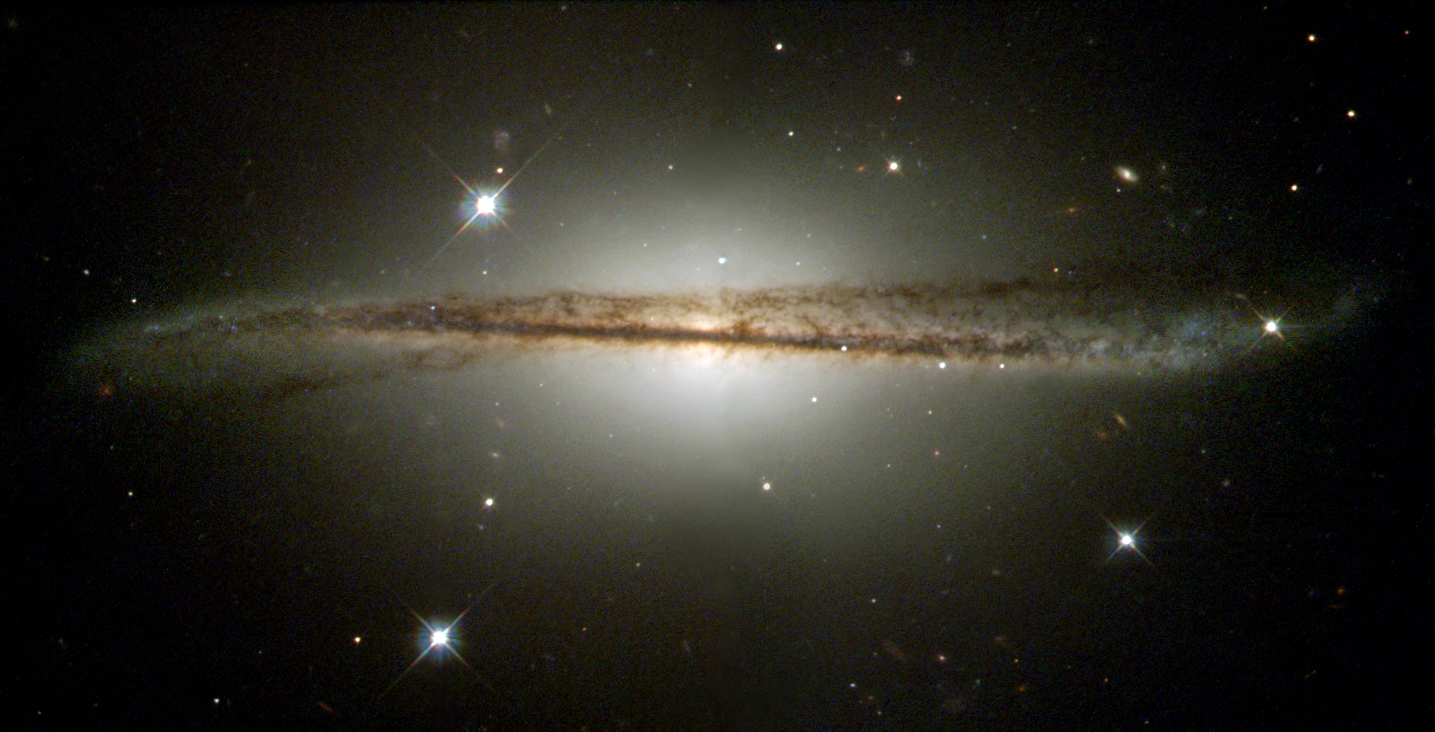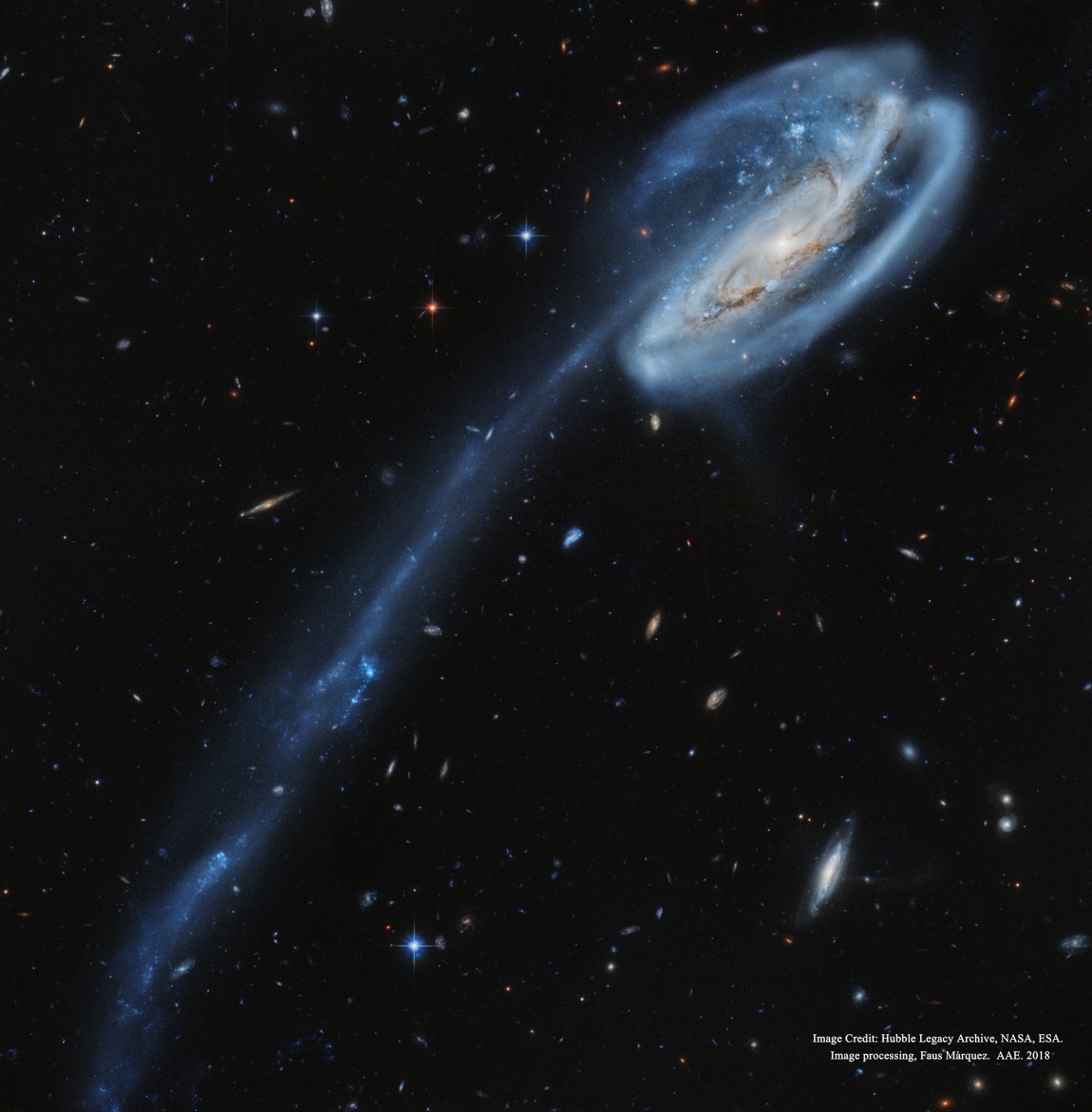|
|
Post by jandl100 on Dec 9, 2018 21:20:17 GMT
|
|
|
|
Post by MartinT on Dec 9, 2018 21:50:17 GMT
The scale of the thing!
|
|
|
|
Post by jandl100 on Jan 4, 2019 5:59:43 GMT
New research shows that the Larger Magellanic Cloud (LMC; a satellite galaxy that orbits our own Milky Way galaxy, visible only from the southern hemisphere) will collide with us in 2 to 3 billion years. They think it will temporarily 'wake up' the black hole in the centre of our galaxy and turn it in to a quasar, a type of active galaxy known for its prodigious energy output. There are some things that make our Milky Way anomalous compared to other spiral galaxies, including the distribution of stars, the relatively small size of the central super-massive black hole and the overall chemical composition of the Milky Way. The new research indicates that the collision with the LMC will sort this out and make the Milky Way typical of its class. One other plausible outcome is that our solar system will be ejected from the galaxy. .... A billion or so years later the Milky Way and the Andromeda galaxy whump into each other and the whole thing goes crazy again. All this galaxy collision stuff is perfectly normal, and in a universal sense is happening all the time.
|
|
|
|
Post by MartinT on Jan 4, 2019 6:48:00 GMT
Brilliant! I'll book front row seats.
|
|
|
|
Post by jandl100 on Jan 4, 2019 7:04:29 GMT
If the solar system gets booted out of the Milky Way a billion years before the Andromeda collision, you may be able to get a really spectacular view of that!
|
|
|
|
Post by jandl100 on Jan 17, 2019 11:56:34 GMT
It seems that about half the stars in the universe are in inter-galactic space, not in galaxies at all. No way they could have formed there, simply not enough material density, so they may well have been slung out of their host galaxies during galactic collisions. www.space.com/27682-rogue-stars-between-galaxies.html |
|
|
|
Post by jandl100 on Feb 5, 2019 8:05:22 GMT
Well, this is a bit embarassing. It seems that our own home galaxy, the Milky Way, isn't a beautifully formed symmetric spiral like the Andromeda galaxy after all. It's bitter and twisted. Probably comes of hosting the human race - that would be enough to disfigure any self respecting galaxy. Artist's impression here ...  www.gizmodo.co.uk/2019/02/new-star-map-reveals-the-milky-way-is-warped/ www.gizmodo.co.uk/2019/02/new-star-map-reveals-the-milky-way-is-warped/Curiously (to my mind) the researchers are blaming the rotational gravitational effects of the inner part of the galaxy for causing the warping - if so, why are only a small porportion of spiral galaxies affected in this way? Beats me! |
|
|
|
Post by MartinT on Feb 5, 2019 9:43:15 GMT
If it were a little longer in the body it would be a barred spiral.
I wonder if the smaller than usual black hole at its centre has much influence on its 'tidiness'?
|
|
|
|
Post by jandl100 on Feb 5, 2019 9:48:07 GMT
|
|
|
|
Post by jandl100 on Feb 6, 2019 8:57:49 GMT
Here's a photo of another galaxy with a disc even more warped than the Milky Way's - it gives a good idea of what is going on. - I've seen it described as like a pancake wobbling in the air as it is flipped!  |
|
|
|
Post by jandl100 on Mar 25, 2019 8:34:36 GMT
 Arp 194: Merging Galaxy Group Why are stars forming in the bridge between these colliding galaxies? Usually when galaxies crash, star formation is confined to galaxy disks or tidal tails. In Arp 194, though, there are bright knots of young stars right in a connecting bridge. Analyses of images and data including the featured image of Arp 194 from Hubble, as well as computer simulations of the interaction, indicate that the bottom galaxy passed right through the top galaxy within the past 100 million years. The result has left a stream of gas that is now falling toward the bottom galaxy.Astronomers hypothesize that stars form in this bridge because of the recent fading of turbulence after the rapid collision. In about a billion years, the galaxies -- including a smaller galaxy superposed on the upper galaxy (see it?) -- will all merge into one larger galaxy. Hubble Space Telescope . |
|
|
|
Post by MartinT on Mar 25, 2019 9:29:53 GMT
Fascinating!
|
|
|
|
Post by jandl100 on Mar 25, 2019 20:16:29 GMT
Phab photo of the "Tadpole galaxy".  In this stunning vista, based on image data from the Hubble Legacy Archive, distant galaxies form a dramatic backdrop for disrupted spiral galaxy Arp 188, the Tadpole Galaxy. The cosmic tadpole is a mere 420 million light-years distant toward the northern constellation of the Dragon (Draco). Its eye-catching tail is about 280 thousand light-years long and features massive, bright blue star clusters. One story goes that a more compact intruder galaxy crossed in front of Arp 188 - from right to left in this view - and was slung around behind the Tadpole by their gravitational attraction. During the close encounter, tidal forces drew out the spiral galaxy's stars, gas, and dust forming the spectacular tail. The intruder galaxy itself, estimated to lie about 300 thousand light-years behind the Tadpole, can be seen through foreground spiral arms at the upper right. Following its terrestrial namesake, the Tadpole Galaxy will likely lose its tail as it grows older, the tail's star clusters forming smaller satellites of the large spiral galaxy. NASA |
|
|
|
Post by MartinT on Mar 25, 2019 20:23:23 GMT
The distances are beyond comprehension.
|
|
|
|
Post by jandl100 on Mar 31, 2019 19:12:31 GMT
|
|
|
|
Post by jandl100 on Mar 31, 2019 19:18:23 GMT
not colliding but still awesome  |
|
|
|
Post by jandl100 on Aug 5, 2019 18:17:49 GMT
Well, this is a bit embarassing. It seems that our own home galaxy, the Milky Way, isn't a beautifully formed symmetric spiral like the Andromeda galaxy after all. It's bitter and twisted. Probably comes of hosting the human race - that would be enough to disfigure any self respecting galaxy. Artist's impression here ...  www.gizmodo.co.uk/2019/02/new-star-map-reveals-the-milky-way-is-warped/ www.gizmodo.co.uk/2019/02/new-star-map-reveals-the-milky-way-is-warped/Curiously (to my mind) the researchers are blaming the rotational gravitational effects of the inner part of the galaxy for causing the warping - if so, why are only a small porportion of spiral galaxies affected in this way? Beats me! More on the twisting of the Milky Way's disk .... |
|
|
|
Post by jandl100 on Sept 6, 2019 16:21:30 GMT
This is such an amazing and beautiful photo I thought I'd share it. Note the Large and Small Magellanic Clouds, satellite galaxies to the Milky Way, only visible from south of the equator. Milky way above the Good shepherd's church Credit : Yulin Xing Location : Lake Tekapo, New Zealand  |
|
|
|
Post by jandl100 on Sept 6, 2019 19:54:44 GMT
^
That's our home galaxy, it's where we live.
We are out in the suburbs looking in toward the centre.
|
|
|
|
Post by Firebottle on Sept 7, 2019 7:07:03 GMT
I've had the privilege of seeing the milky way a few times in a totally dark environment, before they put a couple of street light in the village in France.
That image is amazing.
|
|